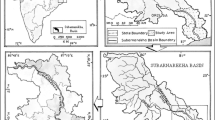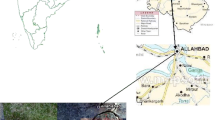Abstract
This paper applied the Revised Universal Soil Loss Equation (RUSLE), remote-sensing technique, and geographic information system (GIS) to map the soil erosion risk in Miyun Watershed, North China. The soil erosion parameters were evaluated in different ways: the R factor map was developed from the rainfall data, the K factor map was obtained from the soil map, the C factor map was generated based on a back propagation (BP) neural network method of Landsat ETM+ data with a correlation coefficient (r) of 0.929 to the field collected data, and a digital elevation model (DEM) with a spatial resolution of 30 m was derived from topographical map at the scale of 1:50,000 to develop the LS factor map. P factor map was assumed as 1 for the watershed because only a very small area has conservation practices. By integrating the six factor maps in GIS through pixel-based computing, the spatial distribution of soil loss in the upper watershed of Miyun reservoir was obtained by the RUSLE model. The results showed that the annual average soil loss for the upper watershed of Miyun reservoir was 9.86 t ha−1 ya−1 in 2005, and the area of 47.5 km2 (0.3%) experiences extremely severe erosion risk, which needs suitable conservation measures to be adopted on a priority basis. The spatial distribution of erosion risk classes was 66.88% very low, 21.90% low, 6.19% moderate, 2.90% severe, and 1.84% very severe. Among all counties and cities in the study area, Huairou County is in the extremely severe level of soil erosion risk, about 39.6% of land suffer from soil erosion, while Guyuan County in the very low level of soil erosion risk suffered from 17.79% of soil erosion in 2005. Therefore, the areas which are in the extremely severe level of soil erosion risk need immediate attention from soil conservation point of view.









Similar content being viewed by others
References
Angima SD, Stott DE, O’Neill MK, Ong CK, Weesies GA (2003) Soil erosion prediction using RUSLE for central Kenyan highland conditions. Agric Ecosyst Environ 97:295–308
Bali YP, Karale RL (1977) A sediment yield index for choosing priority basins, vol 222. IAHS-AISH Publ, p 180
Bartsch KP, van Miegroet H, Boettinger J, Dobrwolski JP (2002) Using empirical erosion models and GIS to determine erosion risk at Camp Williams. J Soil Water Conserv 57:29–37
Boggs G, Devonport C, Evans K, Puig P (2001) GIS-based rapid assessment of erosion risk in a small Watershed in the wet/dry tropics of Australia. Land Degrad Dev 12(5):417–434
Bu ZH, Tang WL, Yang LZ, Xi CF, Liu FX, Wu JY, Tang HN (2003) The progress of quantitative remote sensing method for annual soil losses and its application in Taihu-Lake Watersheds. Acta Pedol Sin (in Chinese) 40(1):1–9
Cerri CEP, Dematte JAM, Ballester MVR, Martinelli LA, Victoria RL, Roose E (2001) GIS erosion risk assessment of the Piracicaba River Basin, southeastern Brazil. Mapp Sci Remote Sens 38:157–171
Chen WH, Liu LY, Zhang C, Pan YC, Wang JH, Wang JD (2005) The fast method of soil erosion investigation based on remote sensing. Res Soil Water Conserv 12:8–10
Chen T, Li PX, Zhang LP (2008) Retrieving vegetation cover by using BP neural network based on “Beijing-1” microsatellite data. In: the International conference on earth observation data processing and analysis (ICEODPA2008), 28–30 December, 2008, China
Chinese River Sediment Bulletin (2006) The Ministry of Water Resources of the People’s Republic of China
Chinese Soil Taxonomy Research Group, Institute of Soil Science, Academia Sinica and Cooperative Research Group on Chinese Soil Taxonomy (1995) Chinese soil taxonomy (Revised proposal). China Agricultural Science and Technology Press, Beijing
Deore SJ (2005) Prioritization of micro-watersheds of upper Bhama Basin on the basis of soil erosion risk using remote sensing and GIS technology. Ph.D. Thesis, Department of Geography, University of Pune
Dymond JR, Stephens PR, Newsome PF, Wilde RH (1992) Percent vegetation cover of a degrading rangeland from SPOT. Int J Remote Sens 13(11):1999–2007
Graetz RD, Pech RR, Davis AW (1988) The assessment and monitoring of sparsely vegetated rangelands using calibrated Landsat data. Int J Remote Sens 9(7):1201–1222
Grepperud S (1995) Soil conservation and government policies in tropical area: does aid worsen the incentives for arresting erosion. Agric Econ 12:120–140
Homik K, Stinchcombe M, White H (1989) Multi-layer feed forward networks are universal approximators. Neural Netw 2:359–366
Jose CS, Das DC (1982) Geomorphic prediction models for sediment production rate and intensive priorities of watersheds in Mayurakshi Watershed. In: Proceedings of the international symposium on hydrological aspects of mountainous watershed held at the School of Hydrology. University of Roorkee, vol I, no 4–6, pp 15–23
Lal R (1998) Soil erosion impact on agronomic productivity and environment quality: critical reviews. Plant Sci 17:319–464
Li ZG, Luo ZD (2006) On method for evaluating soil erosion severity in county scale—index of soil erosion severity and its application. Bull Soil Water Conserv 26:41–51
Liu BY, Nearing MA, Shi PJ, Jia ZW (2000) Slope length effects on soil loss for steep slopes. Soil Sci Soc Am J 64:1759–1763
Ma JW, Xue Y, Ma CF, Wang ZG (2003) A data fusion approach for soil erosion monitoring in the Upper Yangtze River Basin of China based on Universal Soil Loss Equation (USLE) model. Int J Remote Sens 24:4777–4789
Mati BM, Veihe A (2001) Application of the USLE in a savannah environment: comparative experiences from east and west Africa. Singap J Trop Geogr 22:138–155
Millward AA, Mersey JE (1999) Adapting the RUSLE to model soil erosion potential in a mountainous tropical watershed. Catena 38:109–129
Misra N, Satyanarayana T, Mukherjee RK (1984) Effect of top elements on the sediment production rate from Sub-watershed in Upper Damodar Valley. J Agric Eng 21(3):65–70
Purevdorj TS, Tateishi R, Ishiyama T, Honda Y (1998) Relationships between percent vegetation cover and vegetation indices. Int J Remote Sens 19(18):3519–3535
Qiao YL, Qiao Y (2002) Fast soil erosion investigation and dynamic analysis in the loess plateau of China by using information composite technique. Adv Space Res 29:85–88
Renard KG, Foster GA, Weesies GA, McCool DK (1997) Predicting soil erosion by water: a guide to conservation planning with RUSLE. USDA, Agriculture Handbook No. 703, Washington, DC
Reusing M, Schneider T, Ammer U (2000) Modeling soil erosion rates in the Ethiopian Highlands by integration of high resolution MOMS-02/D2-stereo-data in a GIS. Int J Remote Sens 21:1885–1896
Thampapillai DA, Anderson JR (1994) A review of the socio-economic analysis of soil degradation problem for developed and developing countries. Rev Mark Agric Econ 62:291–315
The Ministry of Water Resources of the People’s Republic of China (1997) National professional standards for classification and gradation of soil erosion, SL 190-1996
Wang G, Gertner G, Fang S, Anderson AB (2003) Mapping multiple variables for predicting soil loss by geostatistical methods with TM images and a slope map. Photogramm Eng Remote Sens 69:889–898
Wilson JP, Lorang MS (2000) Spatial models of soil erosion and GIS. In: Fotheringham AS, Wegener M (eds) Spatial models and GIS: new potential and new models. Taylor & Francis, Philadelphia, PA, pp 83–108
Wischmeier WH, Smith DD (1978) Predicting rainfall erosion losses: a guide to conservation planning. USDA, Agriculture Handbook No. 537, Washington, DC
Yang DZ, Xu XD, Liu XD, Xu Q, Ding GA, Cheng XH, Chen HL, Zhou HG, Wang ZF, Wang WY (2005) Complex sources of air-soil-water pollution processes in the Miyun reservoir region. Sci China Ser D Earth Sci 48(Suppl II):230–245
Zhao XL, Zhang ZX, Liu B, Wang CY (2002) Method of monitoring soil erosion dynamic based on remote sensing and GIS. Bull Soil Water Conserv 22:29–32
Zhou WF, Wu BF (2005) Soil erosion estimation of the upriver areas of Miyun Reservoir located on the Chaobai River using remote sensing and GIS. Trans CSAE 21(10):46–50
Acknowledgments
This work was supported by the National Natural Science Foundation of China under Grant No. 40901205, the open fund of Key Laboratory of Agrometeorological Safeguard and Applied Technique, CMA under Grant No. AMF200905, and the open fund of State Key Lab of Information Engineering in Surveying, Mapping and Remote Sensing, Wuhan University under Grant No. 09R02.
Author information
Authors and Affiliations
Corresponding author
Rights and permissions
About this article
Cite this article
Chen, T., Niu, Rq., Li, Px. et al. Regional soil erosion risk mapping using RUSLE, GIS, and remote sensing: a case study in Miyun Watershed, North China. Environ Earth Sci 63, 533–541 (2011). https://doi.org/10.1007/s12665-010-0715-z
Received:
Accepted:
Published:
Issue Date:
DOI: https://doi.org/10.1007/s12665-010-0715-z




